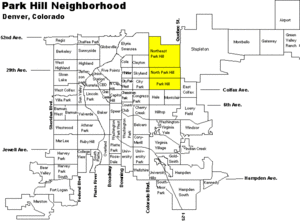Park Hill, Denver facts for kids
Park Hill is a friendly neighborhood in Denver, Colorado, U.S.. It's located in the northeastern part of the city. Park Hill is surrounded by Colorado Boulevard to the west, East Colfax Avenue to the south, Quebec Street to the east, and East 52nd Avenue to the north. The city of Denver divides Park Hill into three smaller areas: South Park Hill, North Park Hill, and Northeast Park Hill.
Contents
History of Park Hill
In 1887, a man named Baron Alois von Winckler started the first development in Park Hill. He owned a large piece of land, about 32 acres, located east of City Park. This first area is now part of what is called South Park Hill.
The very first homes in Park Hill were ready for sale in 1900. As the neighborhood grew, people from many different countries moved there. These included families from England, Denmark, Germany, the Netherlands, and Italy. Many African Americans also made Park Hill their home. After World War II, more homes were built, especially in the northern parts of the neighborhood.
Dahlia Square Shopping Center
In the early 1950s, a shopping center called Dahlia Square was built in Northeast Park Hill. It was a very important place for the community, acting as the main shopping area. It had many different businesses, including a grocery store. Over time, the shopping center started to get old and run down. Residents felt it was no longer a good place for the neighborhood.
Starting in the 1990s, people began to think about how to fix up Dahlia Square. Many plans were discussed, but it wasn't until 2005 that a successful plan came together. A company bought the land to clean it up and get it ready for new buildings. By the end of 2005, the old buildings were taken down, and the cleanup of the land began in 2006. This was an important step to bring new life to the area.
Who Lives in Park Hill?
According to information from the U.S. Census, in the year 2000, about 26,422 people lived in Park Hill, in over 10,000 homes. The census showed that the number of different ethnic groups changed from south to north in Park Hill. Also, the average income tended to be higher in the southern parts of the neighborhood.
Overall, Park Hill is a very diverse place. About 39.76 percent of residents were white, and 51.48 percent were African American. There were also people of Asian (2.87 percent) and Native American (1.21 percent) backgrounds. About 17.38 percent of the population identified as Hispanic or Latino.
South Park Hill Residents
In 2010, South Park Hill had about 8,590 residents living in 3,449 homes. This part of Park Hill is mostly non-Latino white residents (77.42 percent). It also has African American (7.97 percent), Asian (2.41 percent), and Native American (0.48 percent) residents. About 8.87 percent of the people in South Park Hill are Hispanic or Latino. In 2000, the average income in South Park Hill was higher than the average for the whole city of Denver.
North Park Hill Residents
In 2000, North Park Hill was home to 10,057 people in 3,944 homes. The racial makeup here was different from South Park Hill. About 29.82 percent were white, and 59.01 percent were African American. There were also Asian (2.14 percent) and Native American (0.96 percent) residents. About 19.44 percent of the population was Hispanic or Latino. The average income in North Park Hill was a little higher than the city's average.
Northeast Park Hill Residents
In 2000, Northeast Park Hill had 7,824 residents living in 2,633 homes. This area had a different mix of people. About 7.54 percent were white, and 70.50 percent were African American. There were also Asian (0.41 percent) and Native American (0.24 percent) residents. About 23.81 percent of the population was Hispanic or Latino. The average income in Northeast Park Hill was lower than the city's average.
When you look at North Park Hill and Northeast Park Hill together, about 68.75 percent of residents were African American. About 14.52 percent were white, and 22.92 percent were Hispanic or Latino.
In November 2017, the average price for a home in Park Hill was about $272 per square foot.
Greater Park Hill Community Organization
The Greater Park Hill Community (GPHC) is a special non-profit group that started in 1961. This organization is mostly run by volunteers. It helps connect local residents and businesses with the City and County of Denver.
The GPHC also publishes a monthly newspaper called the Greater Park Hill News. This newspaper is given out for free to people living in Park Hill and nearby businesses. They also have a Youth Jobs Program that helps young people, aged 12–15, find summer jobs. Every fall, the GPHC organizes an annual event called The Greater Park Hill Home Tour, where people can visit different homes in the neighborhood. This tour has been happening for over 30 years!
Famous People from Park Hill
Many well-known people have connections to Park Hill:
- Chauncey Billups: A basketball player for the Detroit Pistons and winner of the 2004 NBA Finals MVP Award.
- LenDale White: A former running back for the USC and in the NFL.
- Mike Bell: A former running back for the University of Arizona and the Denver Broncos, who grew up in Park Hill.
- Dianne Reeves: A famous jazz singer who lives in Park Hill.
- John Hickenlooper: A former Governor of Colorado, who moved to Park Hill in 2007.
- Rick Reilly: A columnist for ESPN The Magazine and former Sports Illustrated, who was born in Park Hill.
- Pam Grier: An actress and Golden Globe winner, who lived in Park Hill and went to East High School.
- Victoria "Vikki" Buckley: A former Secretary of State of Colorado, who was raised in Park Hill and attended East High School.
Images for kids




